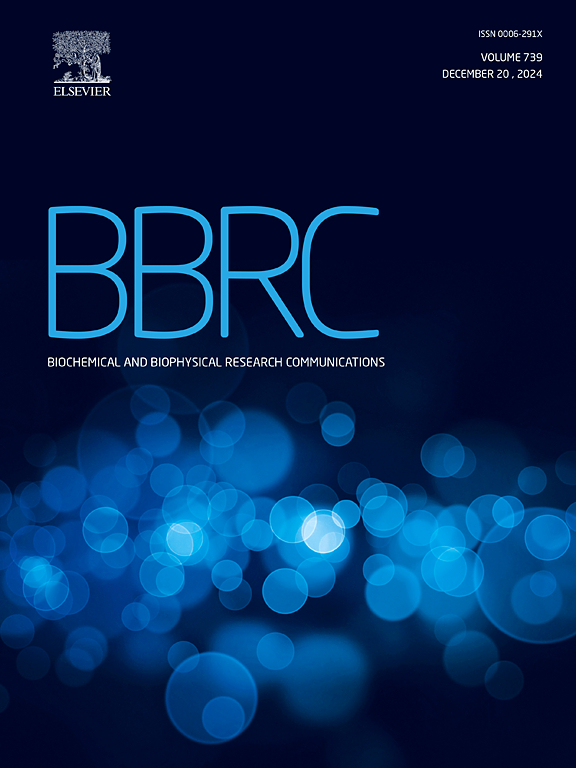槲皮素通过诱导双端 DNA 双链断裂对癌细胞产生细胞毒性。
IF 2.5
3区 生物学
Q3 BIOCHEMISTRY & MOLECULAR BIOLOGY
Biochemical and biophysical research communications
Pub Date : 2024-11-13
DOI:10.1016/j.bbrc.2024.150977
引用次数: 0
摘要
槲皮素是一种黄酮类化合物,除了具有抗氧化特性外,还参与诱导DNA双链断裂(DSB)。尽管DNA拓扑异构酶II(Top2)和活性氧(ROS)被认为是槲皮素诱导DSB的可能机制,但其确切机制仍不清楚。在这项研究中,我们使用 HeLa 细胞和由人类 Nalm-6 细胞产生的基因敲除细胞系研究了槲皮素诱导 DSB 及其修复的机制。DSB标记物γH2AX的免疫荧光染色以及与DSB数量和DSB修复途径相关的外来DNA随机整合频率分析表明,槲皮素以浓度依赖性方式诱导DSB。灵敏度试验表明,参与槲皮素诱导 DSB 的因子不是 Top2,但在槲皮素处理过的 HeLa 细胞中发现 ROS 短暂积累。此外,抗坏血酸的加入提高了槲皮素处理的 HeLa 细胞的存活率,这表明槲皮素诱导了 ROS 的短暂积累,进而诱导了 DSB。产生的DSB主要通过非同源末端连接和同源重组进行修复,这与X射线诱导的DSB相似。综上所述,槲皮素作为一种放射模拟剂,有可能在风险相对较低的情况下产生相当于X射线剂量的效应。本文章由计算机程序翻译,如有差异,请以英文原文为准。
Quercetin exhibits cytotoxicity in cancer cells by inducing two-ended DNA double-strand breaks
Quercetin, a flavonoid, is involved in the induction of DNA double-strand breaks (DSBs), in addition to its antioxidant properties. Although DNA topoisomerase II (Top2) and reactive oxygen species (ROS) have been suggested as possible mechanisms through which quercetin induces DSBs, the exact mechanism remains unclear. In this study, we examined the mechanism of DSB induction by quercetin and its repair using HeLa cells and gene-knockout cell lines generated from human Nalm-6 cells. Immunofluorescence staining for γH2AX, a DSB marker, and analysis of the frequency of random integration of foreign DNA, which correlates with the number of DSBs and DSB repair pathways, indicated that quercetin induces DSBs in a concentration-dependent manner. The sensitivity assay suggested that the factor involved in quercetin-induced DSBs was not Top2. However, ROS was found to accumulate transiently in quercetin-treated HeLa cells. Furthermore, the addition of ascorbic acid increased the survival of quercetin-treated HeLa cells, suggesting that quercetin induces a transient accumulation of ROS, which in turn induces DSBs. The resulting DSBs were repaired primarily by non-homologous end-joining and homologous recombination, similar to X-ray-induced DSBs. Taken together, quercetin, used as a radiomimetic agent, has the potential to produce effects equivalent to those of an X ray-dose at a relatively low risk.
求助全文
通过发布文献求助,成功后即可免费获取论文全文。
去求助
来源期刊
CiteScore
6.10
自引率
0.00%
发文量
1400
审稿时长
14 days
期刊介绍:
Biochemical and Biophysical Research Communications is the premier international journal devoted to the very rapid dissemination of timely and significant experimental results in diverse fields of biological research. The development of the "Breakthroughs and Views" section brings the minireview format to the journal, and issues often contain collections of special interest manuscripts. BBRC is published weekly (52 issues/year).Research Areas now include: Biochemistry; biophysics; cell biology; developmental biology; immunology
; molecular biology; neurobiology; plant biology and proteomics

 求助内容:
求助内容: 应助结果提醒方式:
应助结果提醒方式:


